Mad Hedge Technology Letter
June 15, 2018
Fiat Lux
Featured Trade:
(DINNER WITH LAM RESEARCH),
(LRCX), (AMAT), (ASML), (TOELY)

Mad Hedge Technology Letter
June 15, 2018
Fiat Lux
Featured Trade:
(DINNER WITH LAM RESEARCH),
(LRCX), (AMAT), (ASML), (TOELY)

It was one of those normally mundane seasonal events.
But what I heard blew my mind and will substantially shape my trading and investment strategy for 2018.
By now you already know that I used some of my stock market winnings this year to buy a vintage Steinway concert grand piano (click here for "The Great Inflation Hedge You've Never Heard Of."
Well, you can't own a Steinway without a recital, and ours was held last weekend.
After listening to an assortment of children display their skills with Pachelbel, Ode to Joy, and The Entertainer, we adjourned for a celebratory buffet dinner.
Making small talk with the other parents, I asked one particularly articulate gentleman what he did for a living. He, too, had enjoyed an excellent year, and also used his profits to buy a Steinway, although his was a cheaper upright model.
It turned out that he was the chief technology officer at LAM Research (LRCX).
Had I heard of it?
Not only did I know the company intimately, I had recommended it to my clients and caught the better part of the nearly 400% move since the beginning of 2016. Furthermore, I was expecting another double in the share price in the years ahead.
Was I right to be so bullish?
The man then launched into a detailed review of the company's prospects for the next three years.
The blockbuster development that no one outside the industry sees coming is China's massive expansion of its semiconductor production.
More than a dozen gigantic fabrication plants are planned, the scale of which is unprecedented in history. Some of these fabs are 10 times larger than those built previously.
This is creating exponential growth opportunities for the tiny handful of companies that produce the highly specialized machines essential to the manufacture of cutting-edge semiconductors, including Applied Materials (AMAT), ASML (ASML), Tokyo Electron (TOELY), KLA-Tencor, and LAM Research (LRCX).
Everyone in the industry has boggled minds over the demand they are seeing for their products.
The reality is the artificial intelligence is rapidly working its way into all consumer and industrial products far faster than anyone realizes, creating astronomical demand for the chips needed to implement it.
Bitcoin mining is also creating enormous new demand for chips that no one remotely imagined possible even two years ago.
As a result, the industry has been caught flat-footed with severe capacity shortages. They are all racing to add capacity as fast as they can. Profit margins are exploding.
On October 17, (LRCX) announced Q3 revenues of $2.48 billion, a staggering increase of 51.84% over the previous year, and a gross margin of 46.4%. The operating margin was 28%, generating net income of $591 million.
That gives the shares a very reasonable price earnings multiple of 16.95X, a 10% discount to the 18X multiple for the S&P 500. That is an incredible deal for one of the fastest growing companies in America.
Samsung of South Korea was far and away its largest customer, accounting for 38% of total sales.
On November 14, the company announced an eye-popping $2 billion share repurchase program that is certain to drive the price higher.
If there is one dark cloud on the horizon, it is the loss of the research and development tax credit embedded deep in the proposed Republican tax bill.
This will have a noticeable and negative impact on (LRCX)'s bottom line. Still, my friend thought that the company could offset this loss with faster sales growth and margin expansion.
However, many other technology companies in Silicon Valley won't be able to bridge that gap. It is a hugely anti-technology move for the government to take.
My fellow Steinway owner thought that LAM Research could easily see sales double in three years as long as there is no recession, which I believe is at least two years off. As for the share price, he couldn't comment, but remained hopeful, as he was a large owner himself.
Of course, the trick is how to buy a stock that has just risen by 400% in two years. So, you could start scaling in here, and build a larger position over time.
You only get opportunities like this a couple of times a decade, and it's better to be too aggressive than too cautious.
To learn more about LAM Research, please click here to visit the company website.


A Steinway Model D
_________________________________________________________________________________________________
Quote of the Day
"The market always gets it right," said Jim O'Neill, the chairman of Goldman Sachs International, who coined the term "BRIC."

Mad Hedge Technology Letter
May 29, 2018
Fiat Lux
Featured Trade:
(HERE ARE SOME EARLY 5G WIRELESS PLAYS),
(T), (VZ), (INTC), (MSFT), (QCOM), (MU), (LRCX), (CVX), (AMD), (NVDA), (AMAT)

How would you like to be part of the biggest business development in the history of mankind?
This revolution will increase business functionality up to 10 times while flattening costs by up to 90%.
Still interested?
Enter the Internet of Things (IoT).
The Internet of Things (IoT) can be boiled down to Internet connectivity with things.
Your luxury juice maker, hair removal kit, and multi-colored Post-its will soon be online.
No, you won't be able to have Tinder chats with the new connectivity, but embedded sensors, tracking technology, and data mining software will aggregate a digital dossier on how products are performing.
The data will be fed back to the manufacturing company offering a comprehensive and accurate review without ever asking a human.
The magic glue making IoT ubiquitous and stickier than a hornet's nest is the emergence and application of 5G.
4G is simply not fast enough to facilitate the astronomical surge in data these devices must process.
5G is the lubricant that makes IoT products a reality.
Verizon Communications (VZ) and AT&T (T) have been assiduously rolling out tests to select American cities as they lay the groundwork for the 5G revolution.
The aim is for these companies to deliver customers a velocious 1 Gbps (gigabits per second) wireless connection speed.
Delivering more than 10 times the average speed today will be a game changer.
America isn't the only one with skin in the game and some would say we are not even leading the pack.
China Mobile (CHL) is carrying out a bigger test in select Chinese cities, and Chinese telecom company Huawei can lay claim to 10% of the 5G patents.
Americans should start to notice broad-based adoption of 5G networks around 2020.
Once widespread usage materializes, watch out!
It will go down in history books as a transformational headline.
The IoT revolution will follow right after.
Until the 5G rollout is done and dusted, tech companies are licking their chops and preparing for one of the biggest shifts in the tech ecosphere affecting every product, service, and industry.
The worldwide IoT market is poised to mushroom into a $934 billion market by 2025 on the back of cloud computing, big data, autonomous transport technology, and a host of other rapidly emerging technology.
The arrival of 5G will have an astronomical network effect. Companies will be able to enhance product specs faster than before because of the feedback of data accumulated by the tracking technology and sensors.
The appearance of this flashy new technology will spawn yet another immeasurable migration to technological devices by 2020.
In just two years, the world will play host to more than 50 billion connected devices all pumping out data as well as consuming data.
What a frightful thought!
IoT's synergies with new 5G technology will have an unassailable influence on the business environment.
For instance, industrial products in the form of robots and equipment will be a huge winner with 5G and IoT technology.
The industrial IoT market is expected to sprout to $233 billion by 2023.
Robots will pervade deeply into economic provenance acting as the mule for brute strength heavy labor plus more advanced tasks as they become more sophisticated.
Total global spending related to IoT products will surpass 1.4 trillion dollars by 2021, according to the International Data Corporation (IDC).
IoT growth will become most robust in the thriving Asian markets fueled by a bonus tailwind of the fastest growing region in the world.
The advanced automation abilities of Germany and the U.K. will also give them a seat at the table.
Micron CEO Sanjay Mehrotra gushed about the future at Micron's investor day celebrating IoT and data as the way forward. Mehrotra explained that the explosion of IoT products will create a new tidal wave of "growing demand for storage and memory."
Chips are a great investment to grab exposure to the 5G, IoT, and big data movement.
Up until today, the last generation of technological innovation brought consumers computers and smartphones.
That world has moved on.
Open up your eyes and you will notice that literally everything will become a "data center on wheels or on feet."
To arrive at this stage, products will need chips.
As many high-grade chips as they can find.
Data centers are one segment in dire need of chips. This market will more than double from $29 billion in 2017 to $62 billion in 2021.
The general-purpose chip market for servers is cornered by Intel.
Industry insiders estimate Intel's market share at 98% to 99% of data center chips. Clientele are heavy hitters such as Amazon Web Services, Google, and Microsoft Azure along with other industry peers.
The only other players with data server chips out there are Qualcomm (QCOM) and Advanced Micro Devices Inc. (AMD).
However, there have been whispers of Qualcomm shutting down the 48-core Centriq 2400 chip for data centers that was launched only last November after head of Qualcomm's data center division, Anand Chandrasekher, was demoted via reassignment.
AMD's new data center chip, Epyc, has already claimed a few scalps with Baidu (BIDU) and Microsoft Azure promising to deploy the new design.
IoT integration is the path the world will take to adopting full-scale digitization.
Microsoft just announced at its own Build 2018 conference its plans to invest $5 billion into IoT in the next four years.
The Redmond, Washington-based company noted operational savings and productivity gains as two positive momentum drivers that will benefit IoT production.
Consulting firm A.T. Kearny identified IoT as the catalyst fueling a $1.9 trillion in productivity increases while shaving $177 billion off of expenses by 2020.
These cloud platforms give tech companies the optimal stage to win over the hearts and dollars of non-tech and tech companies that want to digitize services.
Many of these companies will have IoT products percolating in their portfolio.
Examples are rampant.
Schneider Electric in collaboration with Microsoft's IoT Azure platform brought solar energy to Nigeria by the bucket full.
The company successfully installed solar panels harnessing its performance using IoT technology through the Microsoft cloud.
Kohler rolled out a new lineup of smart kitchen appliances and bathroom fixtures coined "Kohler Konnect" with the help of Microsoft's Azure IoT platform.
Consumers will be able to remotely fill up the bathtub to a personalized temperature.
Real-time data analytics will be available to the consumer by using the bathroom mirror as a visual interface with touch screen functionality giving users the option to adjust settings to optimal levels on the fly.
Kohler's tie-up with Microsoft IoT technology has proved fruitful with product development time slashed in half.
To watch a video of Kohler's new budding relationship with Microsoft's Azure IoT platform, please click here.
It is safe to say operations will cut out the wastefulness using these new tools.
Look no further than legacy American stocks such as oil and gas producer Chevron (CVX), which wants a piece of the IoT pie.
Chevron announced a lengthy seven-year partnership with Microsoft's Azure platform.
The fiber optic cables inside oil production facilities generate more than 1 terabyte of data per day.
In the Houston, Texas, offices, sensors installed six miles below the surface shoot back data to engineers who monitor human safety and system operations on four continents from the Lone Star State.
The newest facility in Kazakhstan, using state-of-the-art technology, will produce more data than all the refineries in North America combined.
Using the aid of artificial intelligence (A.I.), computers will analyze seismic surveys. This pre-emptive technology customizes solutions before problems can germinate.
The new smart-work environment will multiply worker productivity that has been at best stagnant for the past generation.
To get in on the IoT action, buy shares of companies with solid IoT cloud platforms such as Microsoft and Amazon.
Buy best-of-breed chip companies such as Nvidia (NVDA), Intel (INTC), Advanced Micro Devices (AMD) and Micron (MU).
And buy tech companies that produce wafer fab equipment such as Applied Materials (AMAT) and Lam Research (LRCX).
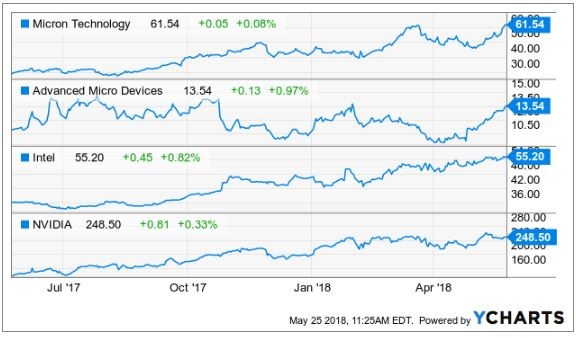
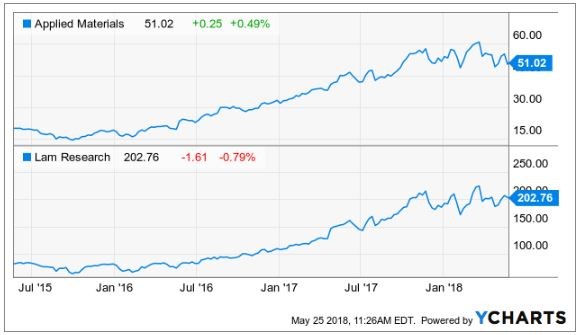
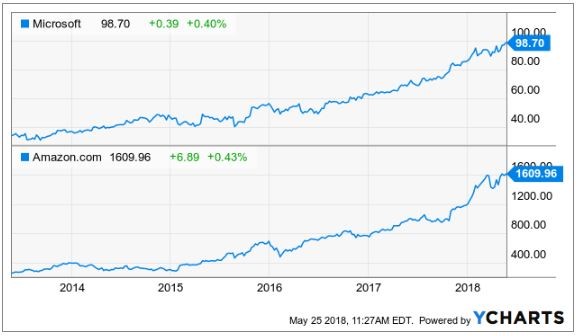

_________________________________________________________________________________________________
Quote of the Day
"Don't be afraid to change the model." - said cofounder and CEO of Netflix Reed Hastings.

Mad Hedge Technology Letter
April 23, 2018
Fiat Lux
Featured Trade:
(HOW NETFLIX CAN DOUBLE AGAIN),
(NFLX), (AMZN), (IQ), (ORCL), (MU), (AMAT), (CRUS), (QRVO), (IFNNY), (NVDA), (JD), (BABA), (MSFT)

The first batch of earnings numbers are trickling in, and on the whole, so far so good.
A spectacular earnings season will further cement tech's position at the vanguard of the greatest bull market in history.
The bull case for technology revolves around two figures indicating "RISK ON" or "RISK OFF".
The first set of numbers from Netflix (NFLX) emanated sheer perfection.
Netflix has gambled on its international audience to drive its growth and unceasing creation of premium content to reach these lofty targets set forth.
It worked.
Consensus was that domestic subscription growth had peaked, and Netflix would have to lean on overseas expansion to beat earnings estimates.
American subscription growth knocked it out of the ballpark, beating expectations by 480,000 subscriptions. The street expected only 1.48 million new adds. The 1.96 million shows the American online streamer is resilient, and the migration toward cord-cutting is happening faster than initially thought.
International adds were pristine, beating the 5.02 million estimates by 440,000 million new subscribers.
Content is king as Netflix has proved time and time again (we notice that here at Mad Hedge Fund Trader, too). Netflix plans to fork out about 700 original series in 2018.
By 2023, Netflix could grow its subscriber base to close to 400 million. The potential for international advancement is immense considering foreign companies are playing catch-up and cannot compete with the level of Netflix's content.
The earnings report coincided with Netflix announcing a forceful push into Europe, doubling its allocated content-related investments to $1 billion.
All of Netflix's estimates take into consideration that it is shut out of the Chinese market. Ironically, the Netflix of China, named iQIYI (IQ), just recently went public on the Nasdaq.
Amazon Web Services (AWS), the cloud-arm of Amazon (AMZN), revenue numbers are the other numbers that are near and dear to the pulsating heartbeat of the bull market.
Jeff Bezos, Amazon's CEO, penned a letter to shareholders that Amazon prime subscribers blew past the 100 million mark.
The positive foreshadowing augurs nicely for Amazon to surprise to the upside when it reports earnings next week on April 26.
Expect more of the same from cloud companies that are overperforming.
The few glitches in tech are minor. It is mindful to stay on the right side of the tracks and not venture into marginal names that haven't proved themselves.
For instance, Oracle (ORCL) had a good, not great, earnings report but shares still cratered after CEO Safra Catz dissatisfied analysts with weak cloud forecasts of just 19%-23% growth.
The street was looking for cloud guidance over 24%. Oracle is still being punished for its legacy tech segments.
The chip sector got pummeled after several chip manufacturers announced weak supply order from Apple.
This is hardly a surprise with Apple slightly missing iPhone estimates last quarter by 1%.
Chip stocks such as Lam Research (LRCX), Micron (MU), and Applied Materials (AMAT) look like affordable bargains. They should be seriously considered after share prices stabilize buttressed by support levels.
The outsized problem is that hardware suppliers have headline risks because of large cap tech's preference toward vertically integrating.
Along with price efficiencies, vertically integration aids design aspects and streamline product production time horizons.
This is not the end of chips.
Consumers need the silicon to generate and extract all the data coming to market.
Particularly, Apple (AAPL) went over its skis trying to push expensive smartphones to a saturated market when all the rip-roaring growth is at the low end of the market.
Apple still managed to sell more than 77 million iPhones, but the trade war rhetoric will deter Chinese consumers from purchasing American tech products. Until now, Apple has counted on China as its best growth prospect. The administration had other ideas.
Any noteworthy Apple supplier has gotten punched in the nose, but crucially, investors must stay out of the SMALLER chip players that rely on narrow revenue sources to keep them afloat.
Bigger chip companies can withstand the shedding of a few revenue sources but not Cirrus Logic (CRUS).
(CRUS) shares have been beaten mercilessly the past year sliding from $68 to a horrifying $37.74 today.
(CRUS) produces audio amplifier chips used in iPhone devices, and weak iPhone X guidance is the cue to bail out of this name.
The company extracts more than 75% of its revenues by selling audio chips used in iPhone devices. Ouch!
Last quarter saw horrific performance, stomaching a 7.7% decline in revenues due to tepid demand for smartphones in Q4 2017.
Cirrus Logic provided an underwhelming outlook, and it is not the only one to be beaten into submission behind the woodshed.
Apple has signaled to its suppliers that it will view production in a different way.
Imagination Technologies, a U.K. company, was informed that its graphic chips are not needed after 2018.
Dialog Semiconductor, another U.K.- based operation, shared the same destiny, as its power management chip was cut out of the production process, sacrificing 74% of revenue.
To top it all off, Apple just announced it plans to manufacture its own MicroLED screens in Silicon Valley, expunging its alliance with Samsung, Sharp, and LG, which traditionally yield smartphone screens for Apple. And Apple plans to make its own chips, phasing out Intel's chips in Apple's MacBook by 2020.
Qorvo (QRVO), Apple's radio frequency chips manufacturer, also can be painted with the same brush.
Apple was responsible for 34% of the company's total revenues in 2017.
Weak iPhone guidance set off a chain reaction, and the trembles were most felt at the bottom feeder group.
Put Infineon Technologies (IFNNY) in the same egg basket as Qorvo and Cirrus Logic. This company installs its cellular basebands in iPhones.
FANG has split into two.
Netflix and Amazon continue producing sublime earnings reports, and Apple and Facebook have hit a relative wall.
It will be interesting if the government's harsh rhetoric toward Amazon amounts to anything.
One domino that could fall is Amazon's lukewarm relationship with the US Postal Service.
Logistics is something the Chinese Amazon's JD.com (JD) and Alibaba (BABA) have successfully adopted. Look for Amazon to do the same.
However, I will say it is unfair that most tech companies are measured against Netflix and Amazon, even for Apple, which earned almost $50 billion in profits in 2017.
It is insane that companies tied to a company that prints money are reprimanded by the market.
But that highlights investors' pedantic fascination with pandemic growth, cloud, and big data.
Making money is irrelevant today. Investors should be laser-like focused on the best growth in tech such as Amazon, Netflix, Lam Research, Nvidia (NVDA), and Microsoft (MSFT), which know how to deliver the perfect cocktail of results that delight investors.
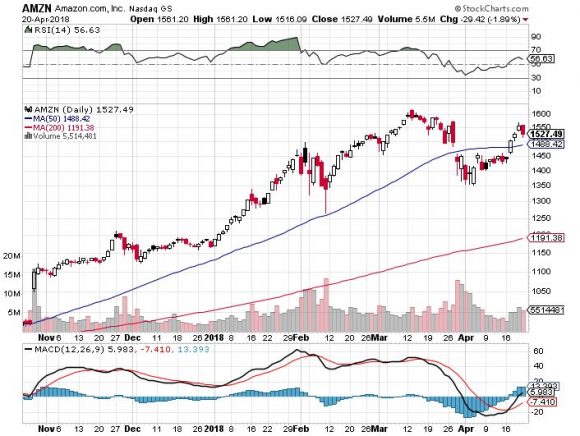
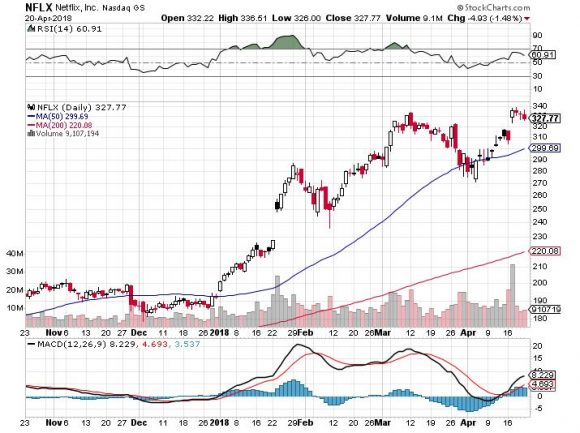
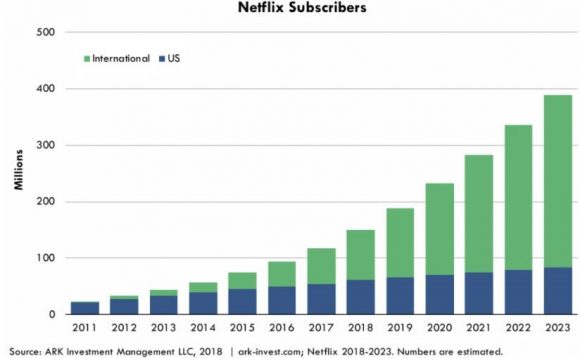
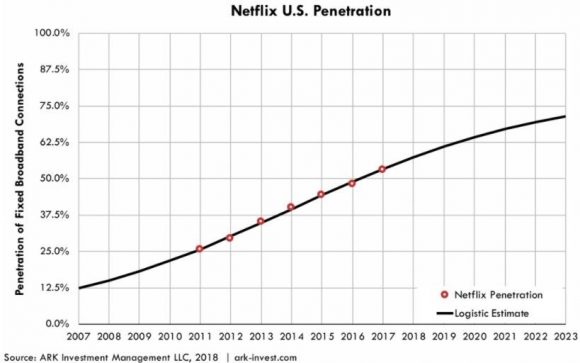
__________________________________________________________________________________________________
Quote of the Day
"$500? Fully subsidized? With a plan? That is the most expensive phone in the world. And it doesn't appeal to business customers because it doesn't have a keyboard. Which makes it not a very good email machine." - said former CEO of Microsoft Steve Ballmer on the introduction of the first iPhone.

Apple blew away the bears today with the issuance of $17 billion in bonds, the largest such corporate debt issue in history. Spread over two, five, ten, and 30 years, the deal was oversubscribed by more than 3:1, with $40 billion in demand left unfilled.
Foreign investors took down a major part of the deal, which explains Deutsche Bank?s senior role in the syndicate. The yield on the ten-year bonds came in at 2.40%, a mere 70 basis points over equivalent US Treasury paper.
The mega deal, dubbed ?iBonds? by traders, underlies the tremendous shortage of high-grade fixed income securities worldwide. Since 2007, the amount of double ?A? or better rated paper has declined by 60%, thanks to widespread downgrades inspired by the newfound religion of the ratings agencies.
As I never tire of pointing out at my strategy luncheons and lectures, the principal sin of governments is not that they are borrowing too much money, but not enough. This has given us a global bond shortage that has taken returns to insanely low levels. Look no further than the ten-year yield of 1.68% in the US, 1.20 % in Germany, and a pitiful 0.60% in Japan.
The issue also highlights the sudden fascination of all things Apple since its better than expected calendar Q1 earnings report last week, with $43 billion in revenues spinning off $9.5 billion in profits. Since then, we learned that the richest man in Russia, Alisher Usmanov, soaked up some $100 million of stock close to the $392 bottom. This is a man who?s proven track record of market timing is uncanny.
It doesn?t require a lot of imagination to figure out what this deal is all about. With $145 billion in cash on the balance sheet, why borrow another $17 billion? The reality is that this is a way of repatriating, through the back door and tax-free, some of the estimated $100 billion in cash the company has parked in offshore bank accounts.
What will it do with the money? How about buying back $17 billion worth of stock? Buy borrowing at 2.4% and retiring 3.2% dividend stock, the yield pick up on the transaction comes to $136 million a year. That goes straight to the bottom line. The deal reminds me of the kind of financial engineering that dominated Japanese finance during the late 1980?s. When I was a director of Morgan Stanley, I signed many of these multi billion dollar deals as a co-manager.
It wasn?t just Apple that has returned from the grave, which saw its stock rise by 14% since last week?s two year low. Look at many of the old tech warhorses, like Microsoft (MSFT), Applied Materials (AMAT), Hewlett Packard (HPQ), and Intel (INTC), which have blasted forth from long moribund levels in recent weeks.
Which raises an interesting possibility. What if the long predicted selloff in May does a no show? What if, instead of the usual 10%-25% swan dive, we only get the 2.5% that has been the pattern for 2013? The possibilities boggle the mind.
In that case where will the money flood into next? Stocks that have been going up like a rocket for the past eight months, or shares that have either fallen like a stone during this time, or barely budged? Stocks that are trading at double the market multiple, or at half the market multiple? Hmmmm. Let me think about this one.
There are two major categories of the latter, commodity related shares and technology ones. China is still slowing, placing a monkey on the back of most commodities related companies. So I vote for technology, which by the way, is the cheapest it has ever been on an earnings multiple basis.
In that case, the strength in old tech will develop into far more than a one-week wonder. It could provide the rocket fuel that will power the major indexes for the rest of the year. That would take the S&P 500 up to 1,700 where it can flaunt a glitzy earnings multiple of 17.
Don?t get too giddy. This is definitely a best-case scenario. But then lately, the best-case scenarios have been happening, thanks to the reflationary efforts of our friend, Ben Bernanke.
That would be fantastic news for Apple?s long-suffering shareholders. Now that its stock has clearly broken through the 50-day moving average on the upside, the eventual target of this leg could be as high as the 200-day moving average at $541. One can only hope.
 Old Tech is Rising From the Dead
Old Tech is Rising From the DeadLegal Disclaimer
There is a very high degree of risk involved in trading. Past results are not indicative of future returns. MadHedgeFundTrader.com and all individuals affiliated with this site assume no responsibilities for your trading and investment results. The indicators, strategies, columns, articles and all other features are for educational purposes only and should not be construed as investment advice. Information for futures trading observations are obtained from sources believed to be reliable, but we do not warrant its completeness or accuracy, or warrant any results from the use of the information. Your use of the trading observations is entirely at your own risk and it is your sole responsibility to evaluate the accuracy, completeness and usefulness of the information. You must assess the risk of any trade with your broker and make your own independent decisions regarding any securities mentioned herein. Affiliates of MadHedgeFundTrader.com may have a position or effect transactions in the securities described herein (or options thereon) and/or otherwise employ trading strategies that may be consistent or inconsistent with the provided strategies.
This site uses cookies. By continuing to browse the site, you are agreeing to our use of cookies.
OKLearn moreWe may request cookies to be set on your device. We use cookies to let us know when you visit our websites, how you interact with us, to enrich your user experience, and to customize your relationship with our website.
Click on the different category headings to find out more. You can also change some of your preferences. Note that blocking some types of cookies may impact your experience on our websites and the services we are able to offer.
These cookies are strictly necessary to provide you with services available through our website and to use some of its features.
Because these cookies are strictly necessary to deliver the website, refuseing them will have impact how our site functions. You always can block or delete cookies by changing your browser settings and force blocking all cookies on this website. But this will always prompt you to accept/refuse cookies when revisiting our site.
We fully respect if you want to refuse cookies but to avoid asking you again and again kindly allow us to store a cookie for that. You are free to opt out any time or opt in for other cookies to get a better experience. If you refuse cookies we will remove all set cookies in our domain.
We provide you with a list of stored cookies on your computer in our domain so you can check what we stored. Due to security reasons we are not able to show or modify cookies from other domains. You can check these in your browser security settings.
These cookies collect information that is used either in aggregate form to help us understand how our website is being used or how effective our marketing campaigns are, or to help us customize our website and application for you in order to enhance your experience.
If you do not want that we track your visist to our site you can disable tracking in your browser here:
We also use different external services like Google Webfonts, Google Maps, and external Video providers. Since these providers may collect personal data like your IP address we allow you to block them here. Please be aware that this might heavily reduce the functionality and appearance of our site. Changes will take effect once you reload the page.
Google Webfont Settings:
Google Map Settings:
Vimeo and Youtube video embeds:
